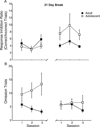Differences in response initiation and behavioral flexibility between adolescent and adult rats
- PMID: 23398439
- PMCID: PMC4075123
- DOI: 10.1037/a0031328
Differences in response initiation and behavioral flexibility between adolescent and adult rats
Abstract
Adolescence is a period of increased vulnerability to psychiatric illnesses such as addiction, mood disorders, and schizophrenia. Rats provide a useful animal model for investigating the differences in behavior and biology between adults and adolescents that stem from ongoing brain development. We developed the Cued Response Inhibition Task, or CRIT, to assess response inhibition and initiation processes by measuring the ability of rodents to withhold a response during an inhibitory cue and then to respond promptly after cue termination. We found no difference between adult and adolescent rats in the ability to appropriately inhibit a response during cue presentation. Adolescents, however, were unable to initiate a response as quickly as adults after cue termination. Further, we observed that this difference in responding was abolished after adolescent rats aged to adulthood with no additional training. In a separate experiment, adult and adolescent rats were trained in CRIT and then trained in another protocol in which the response inhibitory cue from CRIT was used as a Pavlovian cue predictive of reward. Adolescents demonstrated more reward-seeking behavior during the previously inhibitory Pavlovian cue than adults, indicative of greater behavioral flexibility. Taken together, these data suggest that, compared with adults, adolescent rats (a) are less able to initiate a response after response inhibition, (b) equally inhibit behavioral responses, and (c) are more adept at flexibly switching behavioral patterns. Furthermore, this study characterizes a task that is well suited for future pharmacological and electrophysiological investigations for assessing neuronal processing differences between adolescents and adults.
(PsycINFO Database Record (c) 2013 APA, all rights reserved).
Figures






Similar articles
-
A comparison of adult and adolescent rat behavior in operant learning, extinction, and behavioral inhibition paradigms.Behav Neurosci. 2011 Feb;125(1):93-105. doi: 10.1037/a0022038. Behav Neurosci. 2011. PMID: 21319891
-
Adolescents exhibit behavioral differences from adults during instrumental learning and extinction.Behav Neurosci. 2010 Feb;124(1):16-25. doi: 10.1037/a0018463. Behav Neurosci. 2010. PMID: 20141277 Free PMC article.
-
Roles of nucleus accumbens core and shell in incentive-cue responding and behavioral inhibition.J Neurosci. 2011 May 4;31(18):6820-30. doi: 10.1523/JNEUROSCI.6491-10.2011. J Neurosci. 2011. PMID: 21543612 Free PMC article.
-
Modulation of behavior by expected reward magnitude depends on dopamine in the dorsomedial striatum.Neurotox Res. 2009 Feb;15(2):97-110. doi: 10.1007/s12640-009-9009-1. Epub 2009 Feb 12. Neurotox Res. 2009. PMID: 19384572
-
Setting the occasion for adolescent inhibitory control.Neurobiol Learn Mem. 2017 Sep;143:8-17. doi: 10.1016/j.nlm.2016.11.010. Epub 2016 Nov 15. Neurobiol Learn Mem. 2017. PMID: 27864087 Free PMC article. Review.
Cited by
-
Incubation of Oxycodone Craving Following Adult-Onset and Adolescent-Onset Oxycodone Self-Administration in Male Rats.Front Behav Neurosci. 2021 Jun 23;15:697509. doi: 10.3389/fnbeh.2021.697509. eCollection 2021. Front Behav Neurosci. 2021. PMID: 34248518 Free PMC article.
-
Reinforcement learning and Bayesian inference provide complementary models for the unique advantage of adolescents in stochastic reversal.Dev Cogn Neurosci. 2022 Jun;55:101106. doi: 10.1016/j.dcn.2022.101106. Epub 2022 Apr 22. Dev Cogn Neurosci. 2022. PMID: 35537273 Free PMC article.
-
Neural processing of reward in adolescent rodents.Dev Cogn Neurosci. 2015 Feb;11:145-54. doi: 10.1016/j.dcn.2014.11.001. Epub 2014 Nov 22. Dev Cogn Neurosci. 2015. PMID: 25524828 Free PMC article.
-
Maturation of striatal dopamine supports the development of habitual behavior through adolescence.bioRxiv [Preprint]. 2025 Jan 6:2025.01.06.631527. doi: 10.1101/2025.01.06.631527. bioRxiv. 2025. PMID: 39829737 Free PMC article. Preprint.
-
The impact of social stress during adolescence or adulthood and coping strategy on cognitive function of female rats.Behav Brain Res. 2015 Jun 1;286:175-83. doi: 10.1016/j.bbr.2015.02.047. Epub 2015 Mar 5. Behav Brain Res. 2015. PMID: 25746514 Free PMC article.
References
-
- Adriani W, Laviola G. Elevated levels of impulsivity and reduced place conditioning with d-amphetamine: Two behavioral features of adolescence in mice. Behavioral Neuroscience. 2003;117:695–703. - PubMed
-
- Andrzejewski ME, Schochet TL, Feit EC, Harris R, Mc Kee BL, Kelley AE. A comparison of adult and adolescent rat behavior in operant learning, extinction, and behavioral inhibition paradigms. Behavioral Neuroscience. 2011;125:93–105. - PubMed
-
- Burton CL, Fletcher PJ. Age and sex differences in impulsive action in rats: The role of dopamine and glutamate. Behavioural Brain Research. 2012;230:21–33. - PubMed
Publication types
MeSH terms
Grants and funding
LinkOut - more resources
Full Text Sources
Other Literature Sources

